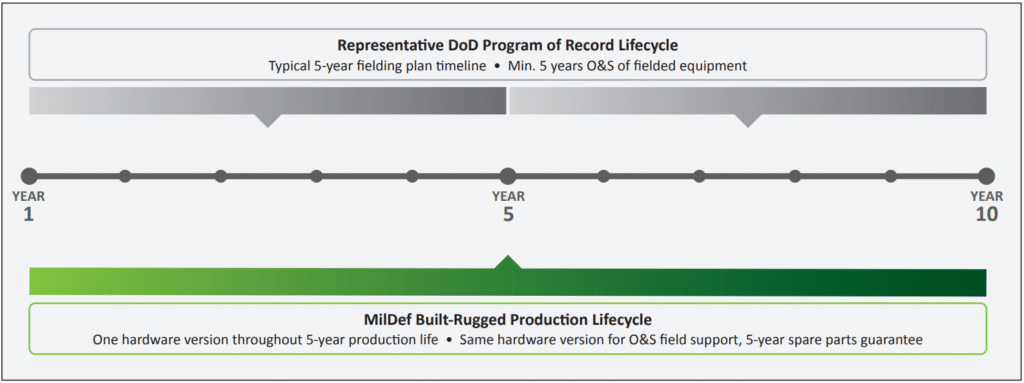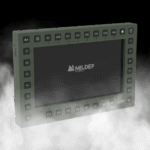2 Keys to Getting Today’s Technology in the Hands of Soldiers—Today
A stated need across the operational forces of the military is getting today’s technology in the hands of the soldiers—today. Commercial computers ruggedized for military use have, at times, provided a solution in terms of speed and availability. When it comes to tactical computers needed for missions carried out under the harshest environmental conditions, however, the stakes are too high. Military service members need to be able to rely on their computers and electronics to perform in almost any environment.

The goal, then, is getting today’s technology in the soldiers’ hands today—but in a survivable and sustainable fashion. From a sourcing perspective, the importance of sourcing truly rugged computers from a military-focused OEM goes beyond durability:
1. A military-focused OEM can align production and sustainment lifecycles with the Department of Defense’s (DOD) product development timelines, while commercial computer vendors are hamstrung by commercial lifecycle processes.
2. A military-focused OEM can focus on quality over quantity, and therefore offer customization of even small volumes of rugged computers, while customization of a commercial computer incurs great cost and production delays, if available at all.
This white paper will review these two commercial constraints and their implications on military program design, as well as present an accelerated sustainable model that meets the needs and timelines of DOD program development.
1: Source ‘Built-Rugged’ rather than Ruggedized Computers
If you put the market for rugged mobile electronics on a spectrum of users, you would have the military and defense industry on one end, professions that require travel and outdoor work—insurance adjusters or delivery drivers, for example—would be somewhere in the middle, and at the other end would be consumers who want personal electronics that can withstand the drops and spills of everyday life.
Commercial computers ruggedized for military use
Very few hardware vendors focus on the design and manufacture of computers solely for the military. More often, a vendor will ‘ruggedize’ a commercially oriented laptop, tablet, or smartphone with a durable covering. Some mainstream hardware vendors will even have their ruggedized offerings undergo a subset of one of the military certifications for durability; for example, MIL-STD 810G, but a closer look reveals compliance with only a scattering of the guidelines that make up the standard.
Encasing off-the-shelf electronics in a rugged package is a cost-effective compromise that benefits commercial computer vendors: they can market a slightly different version of the same product to the military segment without changing product design or internal processes. But the military operates in harsh conditions where “one-size-fits-all” is simply insufficient, both in product design and sustainment.
Misalignment with DOD Programs of Record
The production lifecycle for ruggedized commercial computers—typically 18 months—is necessarily the same as that of the manufacturer’s commercial laptops. This synchronization benefits the provider in terms of cost optimization, but the incongruence is a considerable disadvantage for both military planners and those using the products in the field.
DOD Program Management
Ruggedized commercial computers, with their production lifecycle of 18 months, are a fundamental mismatch for the two-to-three-year Program of Record acquisition cycle. By the time a program is ready for production, for example, the laptop it includes has already gone End-of-Life. Or, when program managers attempt a second buy of the commercial product, they are forced to purchase the next iteration, which may not be form-fit-function with the rest of the program design. The options from there are costly: start over entirely or undergo a full requalification.
DOD Operations & Support (O&S)
Once a completed DOD program is out in the field (typically for a period of five years and more), the responsibility of maintaining that equipment shifts to an O&S organization, which can be left without support at the time when support is most needed.
The O&S supporting activity, when tasked with repair/reset/overhaul of fielded commercial computing products, often discover that spare parts are no longer available after the product’s commercial End-of-Life. This impacts operational mission readiness and results in costly remedies for repairing the fielded commercial products.
‘Built rugged’ computers designed for the military
Military personnel need mission-fit computing and communication solutions that are designed, tested, and qualified for the most extreme environments and tactical scenarios. That means electronics that have been put through rigorous testing and certifications for durability, including extreme temperatures, dust and water ingress, radiation and more.
As an OEM solely focused on the military, MilDef has structured all processes—from concept design to component sourcing to rapid prototyping and customization—to get soldiers the technology they need, when they need it. By maintaining its own supply chain and developing all systems board-level up, MilDef is able to control product lifecycles, whereas other ruggedized computer providers have to rely on the lifecycles of commercially available products. Addressing survivability and sustainability at every stage results in a truly rugged product that not only passes any required tests, but will also be supported for an appropriate amount of time once the product is out in the field.
Survivability & Sustainment Timelines of Rugged Military Computers


2: Consider customization over a development restart
When it comes to the design and manufacture of computers, the word ‘customization’ is synonymous with added costs and delivery delays. Over the years, commercial hardware production has been streamlined to the most cost-effective model, one that cannot easily accommodate product customizations. For this reason, most commercial computer providers only offer the ability to customize large volumes of product. Meanwhile, the 18-month lifecycle of commercial laptops and handhelds ticks on, ensuring that any commercial computer the military includes in a defense program will soon be End-of-Life and thus will need to be replaced.
Rapid customization of military-rugged computers
At MilDef, product customization is an integrated part of delivering mission-fit, innovative, rugged electronics designed specifically for the defense sector. Rather than render an entire system obsolete when a replacement laptop or handheld is unavailable, you can customize MilDef products in any way to fit your existing systems. One MilDef customer needed to replace a legacy laptop—one part of a much larger radar system—that had been built with a D38999 connector with LAN signals and input power. We were able to modify our rugged laptop by adding the same connector in the same position, thereby helping our customer connect to upgraded technology while avoiding hefty re-integration costs. Another customer needed a data management platform for a C-130 that could withstand extreme vibration and other stringent MIL-810G requirements. At that time, a product that could satisfy this customer’s functional and rugged requirements didn’t exist.
Whether it’s additional MIL-STD qualifications, legacy interfaces, integrated tactical modems and military GPS, or very specific MIL-spec connectors, we’re able to customize our flagship products to fit our customers’ missions—and still come out on time and within budget. We can typically design and deliver a prototype of a customized solution that is fully compliant to customer specifications in as little as ten weeks.
Downstream product development and customization
Product design and testing to stringent, well-defined standards should be a critical part of rugged hardware production for the military. At MilDef, we not only rigorously test every finished product, but we also test the components that make up the finished product. We employ a downstream design model in which we begin each customized product design with rugged components that we’ve already put through rigorous testing to standards such as MIL-STD 461 and MIL-STD 810. By testing our products at the component level—our building blocks for customized products—we not only ensure the finished product will meet any testing requirement, but also avoid potential production delays.
A ‘working backwards’ design and testing model
In contrast, ruggedizing commercial computers for military use imposes restrictions on the environmental and EMI qualifications the ruggedized version can meet since the commercial components are already designed in by the commercial OEM. This limits the engineering techniques for ruggedization and results in a backwards design and testing approach. In other words, the engineers ruggedizing the product are faced with what MIL-STD qualifications they can meet rather than designing from the outset to the MIL-STD requirements of military programs.
For this reason, it’s not uncommon for the first prototype of a ruggedized computer to fail third-party testing, thereby delaying production. The manufacturer will then tweak the prototype just enough to pass the test, and those tweaks aren’t necessarily passed down to the product based on the prototype.
Product Testing Shortcut:
The MIL-STD 810G Rain Test determines the effectiveness of protective covers, cases, and seals in preventing water penetration. It should go without saying that a rugged laptop should have internally sealed input and output ports. However, too often a manufacturer of ruggedized computers will “seal” a laptop by simply closing the rubber caps over any connectors. This shortcut entirely defeats the purpose of ingress protection since once you plug something into the laptop—and thus realize the very purpose of connectors—you will have broken the “seal” protecting from particle or water ingress.
In contrast, MilDef fully rugged laptops, tablets and handheld devices feature internally sealed I/O ports and fully sealed keyboards. We put our products through water ingress testing with all caps open as that is the most likely battlefield scenario.
The MilDef Difference
MilDef is a leading designer and manufacturer of military-rugged computing, communications and special electronics for the U.S. military. Military computing and communication solutions are the MilDef core, not an ancillary business division. Rather than try to get the armed forces—our customers—to adapt to production and testing shortcuts that save us money, we focus solely on the military, and maintain our status as an Original Equipment Manufacturer (OEM). This allows us to integrate engineering design, managed supply chain and in-house testing, and the results for our customers are short cycle times, rock-solid product and best-value price.



